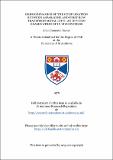Thermodynamics of the complexation between asparagine and first row transition metal ions : an in vitro examination of in vivo systems
Abstract
Thermodynamic parameters have been obtained for the complexes formed between protons, first Transition Series metal ions and the asparaginate ion in aqueous solution at 25°C in an ionic background of 3.00 M (sodium) perchlorate. The metal ions under consideration are manganese(II), iron(II), cobalt(II), nickel(II), copper(II) and zinc(II). The techniques employed were potentiometry to obtain the formation constants (and hence ΔG°) for the complexes, and aqueous titration calorimetry to obtain the corresponding ΔH° (and hence Δs°) values. The results show that iron, cobalt, nickel and zinc are capable of binding up to three asparaginate ligands, whereas for manganese and copper the maximum number of bound ligands is two. All the complexes reported one simple AnB species: no hydroxy, protonated or polynuclear species were detected. The results are used (l) to discuss an unusual "homologue" effect whereby the trends among homologues for bonding to protons and to metal ions are opposite to each other, this apparently being a repercussion of solvation differences between homologues and (2) to show that quite a large proportion of asparaginate in blood plasma may be complexed to Zn(II), Fe(II), and Co(II), as well as the expected Cu(II). The techniques of potentiometry and calorimetry are further employed to determine the thermodynamic parameters for three ternary systems, one, copper(II)-histidinate-threoninate, which is known to exist in vivo, and two others, copper(II)-asparaginate-histidinate and copper(II)-asparaginate-threoninate, which have not yet been detected. Structures are suggested for the complexes Cu.asn.his,H+, Cu.asn.his.thr. , Cu.asn.thr. Cu.his.thr. and Cu.his.thr.H+ . In these complexes histidinate is tridentate to Cu(II), threoninate is bidentate and asparaginate is intermediate between bi and tridentate. The site of proton attachment in the protonated complexes is the primary amine site of the histidinate ligand. Throughout the work extensive use was made of computer programs, all of which are described in the chapter entitled "Computational Aspects".
Type
Thesis, PhD Doctor of Philosophy
Collections
Items in the St Andrews Research Repository are protected by copyright, with all rights reserved, unless otherwise indicated.

